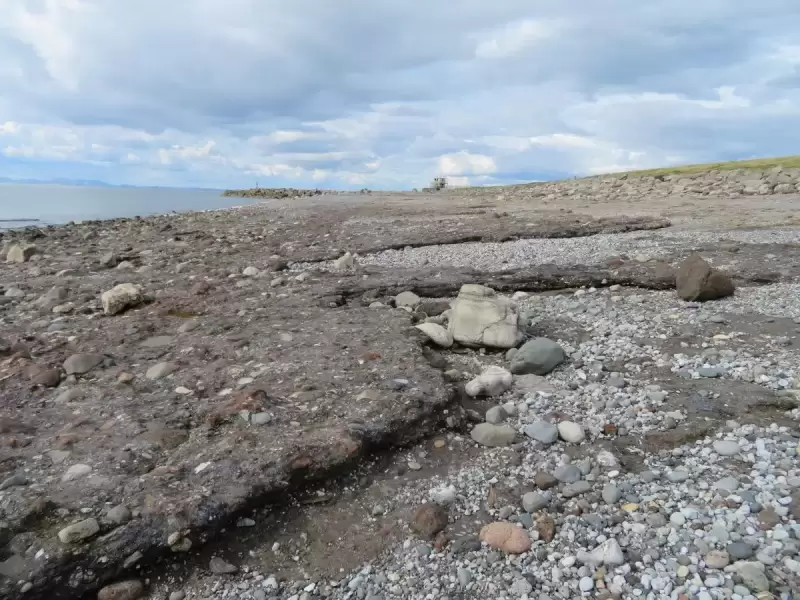 |
|
 |
|
 |
|
 |
|
 |
|
 |
|
 |
|
 |
|
 |
|
 |
|
 |
|
 |
|
 |
|
 |
|
 |
|
Articles d’actualité sur les crypto-monnaies
Industrial waste is turning into rock in decades
Apr 28, 2025 at 07:01 am

Industrial waste is turning into rock in the course of decades, much faster than the millions of years it is thought to take for it to form naturally, research has shown.
A two-kilometre stretch of slag deposit, at Derwent Howe in West Cumbria, has been studied by a team of scientists from the University of Glasgow.
The slag deposits have formed cliffs of waste material which are being eroded by coastal waves and tides, and the team carried out detailed analysis after noticing intriguing irregular formations in the cliffs.
Their findings, published in the journal Geology, show that the formations are in fact new types of rock, forming as a hybrid of natural and technological processes.
The researchers noted that a similar process had previously been observed in the Gorrondatxe coastal system near Bilbao, Spain. However they said that researchers there were unable to determine how long the process had been taking due to the waste being deposited in the sea before being returned to the beach.
At Derwent Howe, the team were able to carry out analysis to show that the rapid rate of rock formation is being driven by the slag’s chemical reactions with seawater and air.
They also found modern materials trapped in some of the samples, which helped them to determine how quickly the process is happening.
The team’s findings suggest that the process could have an impact on ecosystems and said more research is needed.
Their findings came from analysis of a two-kilometre stretch of slag deposit, at Derwent Howe in West Cumbria, which was home to iron and steel-making foundries during the 19th and 20th centuries.
The slag deposits have formed cliffs of waste material which are being eroded by coastal waves and tides, and the team carried out detailed analysis after noticing intriguing irregular formations in the cliffs.
Dr Amanda Owen, of the University of Glasgow’s School of Geographical and Earth Sciences and one of the study’s authors, said: “For a couple of hundred years, we’ve understood the rock cycle as a natural process that takes thousands to millions of years.
“What’s remarkable here is that we’ve found these human-made materials being incorporated into natural systems and becoming lithified – essentially turning into rock – over the course of decades instead.
“It challenges our understanding of how a rock is formed, and suggests that the waste material we’ve produced in creating the modern world is going to have an irreversible impact on our future.”
Laboratory tests helped the researchers determine that Derwent Howe’s slag materials contain deposits of calcium, iron, magnesium, and manganese.
These elements are highly chemically reactive, which is key to causing the accelerated process of rock formation.
When the slag is eroded by the sea, it exposes the material to seawater and air, which interacts with the slag’s reactive elements to create natural cements including calcite, goethite, and brucite.
These cements are the same materials that bind together natural sedimentary rocks, but the chemical reactions cause the process to happen much faster than has been assumed to happen with similar material in a natural rock cycle.
Researchers also found modern materials trapped in some of the samples, which helped them to glean how quickly the process is taking place.
Dr John MacDonald, a co-author of the study, said: “We were able to date this process with remarkable precision.
“We found both a King George V coin from 1934 and an aluminium can tab with a design that we realised couldn’t have been manufactured before 1989 embedded in the material.
“This gives us a maximum timeframe of 35 years for this rock formation, well within the course of a single human lifetime.
“This is an example in microcosm of how all the activity we’re undertaking at the Earth’s surface will eventually end up in the geological record as rock, but this process is happening with remarkable, unprecedented speed.”
The researchers noted that the rapid appearance of rock could fundamentally affect the ecosystems above and below the water, as well as change the way that coastlines respond to the challenges of rising sea levels and more extreme weather as our planet warms.
Dr David Brown, the paper’s third co-author, added: “Currently, none of this is accounted for in our models of erosion of land management, which are key to helping us try to adapt to climate change.
“We’re currently seeking additional funding to help support further research at other slag deposit sites across Europe, which will help to deepen our understanding of this new rapid anthropoclastic rock cycle.”
Clause de non-responsabilité:info@kdj.com
Les informations fournies ne constituent pas des conseils commerciaux. kdj.com n’assume aucune responsabilité pour les investissements effectués sur la base des informations fournies dans cet article. Les crypto-monnaies sont très volatiles et il est fortement recommandé d’investir avec prudence après une recherche approfondie!
Si vous pensez que le contenu utilisé sur ce site Web porte atteinte à vos droits d’auteur, veuillez nous contacter immédiatement (info@kdj.com) et nous le supprimerons dans les plus brefs délais.
-

-

- Doge, pièces de services publics et monnaie intelligente: une nouvelle ère pour l'investissement de cryptographie?
- Aug 03, 2025 at 02:00 am
- Le mème de Doge est-il décoloré? L'argent intelligent envisage des pièces de services publics. Découvrez pourquoi les experts passent du battage médiatique en substance dans le paysage de la cryptographie en évolution.
-

- Punisher Coin: Ce meme est-il de l'investissement en crypto avec un potentiel de ROI 100x?
- Aug 03, 2025 at 02:00 am
- Punisher Coin ($ pun) fait des vagues comme une pièce de mèmes avec un potentiel de retour sur investissement élevé. Découvrez pourquoi il fait tourner les têtes et si c'est le bon investissement cryptographique pour vous.
-

-

-

- Wewake: les investisseurs affluent vers la crypto de prévente en tête alors que l'intégration sans portefeuille prend le devant de la scène
- Aug 03, 2025 at 01:29 am
- Wewake attire l'attention des investisseurs majeure avec sa blockchain innovante sans portefeuille et sans gaz sans gaz. Est-ce l'avenir de l'adoption de la cryptographie?
-

- MEME COINS en 2025: investissement, potentiel de hausse et chats à la traîne?
- Aug 03, 2025 at 01:15 am
- Naviguer dans l'engouement de la pièce MEME de 2025, en se concentrant sur les opportunités d'investissement, le potentiel à la hausse et les pièces hors concours comme Troller Cat, Punisher Coin et autres.
-

- Bitcoin, XRP et The Price Drop Blues: Qu'est-ce que Shakin 'en crypto?
- Aug 03, 2025 at 12:00 am
- Le prix du visage Bitcoin et XRP baisse au milieu de la volatilité du marché, avec des opinions d'experts et des sentiments communautaires ajoutant du carburant à l'incendie. Qu'est-ce qu'un investisseur à faire?
-

- Cold Wallet, Troncoin et Shiba Inu: naviguer dans la cryptographie dans la jungle en béton
- Aug 03, 2025 at 12:00 am
- Explorez le potentiel de Cold Wallet (CWT) avec ses offres de prévente, aux côtés des gains stables de Troncoin et de la rupture potentielle de Shiba INU. Découvrez les idées et les tendances clés.



























































